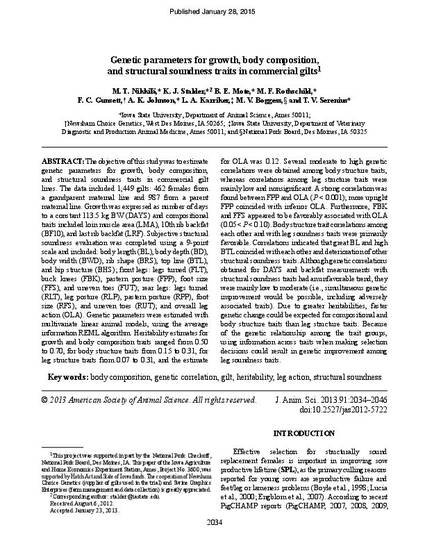
The objective of this study was to estimate genetic parameters for growth, body composition, and structural soundness traits in commercial gilt lines. The data included 1,449 gilts: 462 females from a grandparent maternal line and 987 from a parent maternal line. Growth was expressed as number of days to a constant 113.5 kg BW (DAYS) and compositional traits included loin muscle area (LMA), 10th rib backfat (BF10), and last rib backfat (LRF). Subjective structural soundness evaluation was completed using a 9-point scale and included: body length (BL), body depth (BD), body width (BWD), rib shape (BRS), top line (BTL), and hip structure (BHS); front legs: legs turned (FLT), buck knees (FBK), pastern posture (FPP), foot size (FFS), and uneven toes (FUT); rear legs: legs turned (RLT), leg posture (RLP), pastern posture (RPP), foot size (RFS), and uneven toes (RUT); and overall leg action (OLA). Genetic parameters were estimated with multivariate linear animal models, using the average information REML algorithm. Heritability estimates for growth and body composition traits ranged from 0.50 to 0.70, for body structure traits from 0.15 to 0.31, for leg structure traits from 0.07 to 0.31, and the estimate for OLA was 0.12. Several moderate to high genetic correlations were obtained among body structure traits, whereas correlations among leg structure traits were mainly low and nonsignificant. A strong correlation was found between FPP and OLA (P < 0.001); more upright FPP coincided with inferior OLA. Furthermore, FBK and FFS appeared to be favorably associated with OLA (0.05 < P < 0.10). Body structure trait correlations among each other and with leg soundness traits were primarily favorable. Correlations indicated that great BL and high BTL coincided with each other and deterioration of other structural soundness traits. Although genetic correlations obtained for DAYS and backfat measurements with structural soundness traits had an unfavorable trend, they were mainly low to moderate (i.e., simultaneous genetic improvement would be possible, including adversely associated traits). Due to greater heritabilities, faster genetic change could be expected for compositional and body structure traits than leg structure traits. Because of the genetic relationship among the trait groups, using information across traits when making selection decisions could result in genetic improvement among leg soundness traits.
Available at: http://works.bepress.com/max-rothschild/57/

This is an article from Journal of Animal Science 91 (2013): 2034, doi:10.2527/jas.2012-5722. Posted with permission.